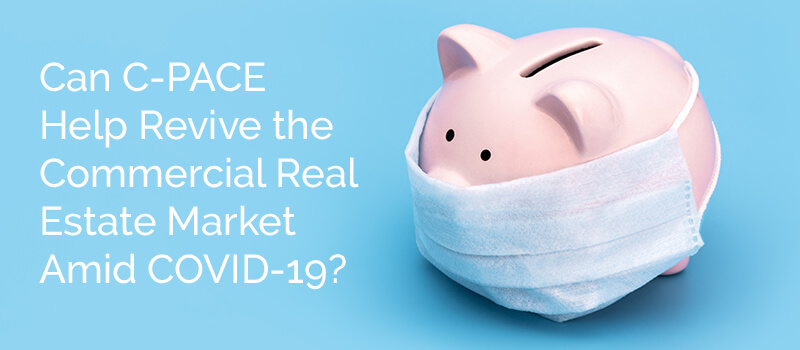
The coronavirus pandemic has dramatically changed the country’s economic landscape, and in particular, the commercial real estate market. We can’t foresee what the long-term impact of the pandemic will be on commercial real estate, but with people choosing to work remotely, travel less, and do more online shopping, the commercial real estate market, and particularly hotels, retail space, and offices – which make up more than half of the mortgages in commercial mortgage-backed securities transactions – will likely have a long road ahead.
Businesses and property owners will need to be innovative in the solutions they seek to weather the storm financially and attract tenants and customers back to their buildings, and C-PACE is one of those innovative solutions that can help revitalize the CRE market during these unprecedented times.
Commercial Property Assessed Clean Energy (C-PACE) is a state policy-enabled financing mechanism that allows building owners and developers to access the capital they need to make energy related deferred maintenance upgrades in their existing buildings, support new construction costs, and make renewable energy accessible and cost-effective. Greenworks Lending – the nation’s largest C-PACE capital provider – can provide fixed rate, non-recourse, low cost capital up to 35% of a property’s value. Additionally, first repayment can be delayed up to 24 months post-closing, bridging properties to stabilization.
While C-PACE has traditionally been used to fund energy-saving retrofits, gut-rehabs, and new construction projects during the construction period, the current public health and economic crisis the country is encountering has resulted in a shift in the use of C-PACE funds toward lesser-known applications such as recapitalization of recently completed C-PACE-eligible projects and the implementation of healthy building measures.
C-PACE as a Tool for Recapitalization:
Utilizing C-PACE as a tool for recapitalization can help alleviate the damages inflicted by the pandemic and provide immediate liquidity for property owners and developers. In many states, C-PACE legislation allows for a “look back” period where property owners and developers to access low-cost, long-term financing with no payment for 24 months to retroactively finance recently completed retrofit and new construction projects.
Proceeds can be used to fund construction cost overruns, replenish operating reserves, cover existing lender debt services, and pay down existing leverage with funding levels up to 35% of property value. Property owners and developers can generally access C-PACE capital with interest rates priced below 6% (fixed) for 20-30 years.
For properties nearing completion, C-PACE can also offer funds for cost overruns and lender pullback, helping to fill that difficult gap in the capital stack. Additionally, with the credit quality that it provides, C-PACE offers better than markets terms and structural flexibility.
C-PACE as a Tool for Healthy Buildings:
The healthy buildings movement is one that has been around for quite some time, but now more than ever property owners are feeling the demand to create safe, healthy, and resilient spaces that mitigate the spread of germs and viruses. Unfortunately, as a result of current economic volatility, property owners might be finding it difficult to access the capital required to implement these healthy buildings measures. Fortunately, C-PACE can help as many of the energy and water efficiency measures that C-PACE can finance are also measures that can help to create a healthy and resilient building.
Air quality enhancements and touch-free technology measures are two of the major healthy building improvements that C-PACE can finance. Scientists have determined that COVID-19 is highly contagious and predominantly transmitted through the air, which underscores the importance of air purification systems in buildings in order to make tenants and customers safe and comfortable returning to indoor spaces. C-PACE-eligible upgrades to improve the air quality of buildings, by eliminating viruses and bacteria, include HEPA (High-Efficiency Particulate Air) filtration, bi-polar ionization, and UV light purification, all of which help filter out or destroy the virus.
Building improvements that minimize surface contact for tenants and customers may also reduce a building’s energy and water consumption, making them eligible measures for C-PACE financing. By implementing measures such as automatic flushing toilets and motion sensor faucets, which could reduce surface contact in bathrooms and potentially reduce the spread of the virus from surfaces, building owners can provide tenants and customers with greater safety and a sense of comfort.
In addition to creating healthy buildings, upgrades such as air quality enhancement and touch-free technology will also help to lower property owners’ net operating income through increased energy savings. These benefits will likely boost the attractiveness of a building to tenants and occupants as well as help increase property value.
Moving Forward:
The economic challenges from the Covid-19 outbreak have completely upended the commercial real estate industry, and until a vaccine is widely available and proven effective, it is unlikely the CRE market will return to its pre-pandemic state. Until then, property owners and developers will have to continue to seek out new and innovative trends in the real estate market – like C-PACE – to help manage liquidity and attract back tenants and customers.
